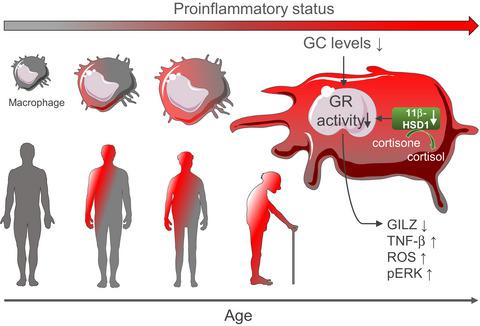当前位置:
X-MOL 学术
›
Aging Cell
›
论文详情
Our official English website, www.x-mol.net, welcomes your feedback! (Note: you will need to create a separate account there.)
Altered glucocorticoid metabolism represents a feature of macroph-aging.
Aging Cell ( IF 7.8 ) Pub Date : 2020-05-28 , DOI: 10.1111/acel.13156 Jenny Vanessa Valbuena Perez 1 , Rebecca Linnenberger 1 , Anna Dembek 1 , Stefano Bruscoli 2 , Carlo Riccardi 2 , Marcel H Schulz 3, 4 , Markus R Meyer 5 , Alexandra K Kiemer 1 , Jessica Hoppstädter 1
Aging Cell ( IF 7.8 ) Pub Date : 2020-05-28 , DOI: 10.1111/acel.13156 Jenny Vanessa Valbuena Perez 1 , Rebecca Linnenberger 1 , Anna Dembek 1 , Stefano Bruscoli 2 , Carlo Riccardi 2 , Marcel H Schulz 3, 4 , Markus R Meyer 5 , Alexandra K Kiemer 1 , Jessica Hoppstädter 1
Affiliation

|
The aging process is characterized by a chronic, low‐grade inflammatory state, termed “inflammaging.” It has been suggested that macrophage activation plays a key role in the induction and maintenance of this state. In the present study, we aimed to elucidate the mechanisms responsible for aging‐associated changes in the myeloid compartment of mice. The aging phenotype, characterized by elevated cytokine production, was associated with a dysfunction of the hypothalamic–pituitary–adrenal (HPA) axis and diminished serum corticosteroid levels. In particular, the concentration of corticosterone, the major active glucocorticoid in rodents, was decreased. This could be explained by an impaired expression and activity of 11β‐hydroxysteroid dehydrogenase type 1 (11β‐HSD1), an enzyme that determines the extent of cellular glucocorticoid responses by reducing the corticosteroids cortisone/11‐dehydrocorticosterone to their active forms cortisol/corticosterone, in aged macrophages and peripheral leukocytes. These changes were accompanied by a downregulation of the glucocorticoid receptor target gene glucocorticoid‐induced leucine zipper (GILZ) in vitro and in vivo. Since GILZ plays a central role in macrophage activation, we hypothesized that the loss of GILZ contributed to the process of macroph‐aging. The phenotype of macrophages from aged mice was indeed mimicked in young GILZ knockout mice. In summary, the current study provides insight into the role of glucocorticoid metabolism and GILZ regulation during aging.
中文翻译:

糖皮质激素代谢改变代表巨噬细胞老化的特征。
衰老过程的特征是慢性低度炎症状态,称为“发炎”。已经提出巨噬细胞活化在该状态的诱导和维持中起关键作用。在本研究中,我们旨在阐明造成小鼠髓样区室衰老相关变化的机制。以细胞因子产生增加为特征的衰老表型与下丘脑-垂体-肾上腺(HPA)轴功能障碍和血清皮质类固醇水平降低有关。特别地,降低了啮齿动物中主要活性糖皮质激素皮质酮的浓度。这可能是由于1型11β-羟基类固醇脱氢酶(11β-HSD1)的表达和活性受损所致,一种酶,可通过在老年巨噬细胞和外周白细胞中将皮质类固醇可的松/ 11-脱氢皮质酮还原成其活性形式皮质醇/皮质酮来确定细胞糖皮质激素反应的程度。这些变化伴随着糖皮质激素受体靶基因糖皮质激素诱导的亮氨酸拉链(GILZ)在体外和体内的下调。由于GILZ在巨噬细胞激活中起着核心作用,因此我们假设GILZ的丧失是巨噬细胞衰老过程的重要原因。实际上,在年轻的GILZ基因敲除小鼠中,模仿了老年小鼠的巨噬细胞表型。总而言之,本研究提供了在衰老过程中糖皮质激素代谢和GILZ调节作用的见解。在衰老的巨噬细胞和外周白细胞中。这些变化伴随着糖皮质激素受体靶基因糖皮质激素诱导的亮氨酸拉链(GILZ)在体外和体内的下调。由于GILZ在巨噬细胞活化中起着核心作用,因此我们假设GILZ的丧失是巨噬细胞衰老过程的重要原因。实际上,在年轻的GILZ基因敲除小鼠中,模仿了老年小鼠的巨噬细胞表型。总而言之,本研究提供了在衰老过程中糖皮质激素代谢和GILZ调节作用的见解。在衰老的巨噬细胞和外周白细胞中。这些变化伴随着糖皮质激素受体靶基因糖皮质激素诱导的亮氨酸拉链(GILZ)在体外和体内的下调。由于GILZ在巨噬细胞激活中起着核心作用,因此我们假设GILZ的丧失是巨噬细胞衰老过程的重要原因。实际上,在年轻的GILZ基因敲除小鼠中,模仿了老年小鼠的巨噬细胞表型。总而言之,本研究提供了在衰老过程中糖皮质激素代谢和GILZ调节作用的见解。我们假设GILZ的丢失是导致巨噬细胞形成过程的原因。实际上,在年轻的GILZ基因敲除小鼠中,模仿了老年小鼠的巨噬细胞表型。总而言之,本研究提供了在衰老过程中糖皮质激素代谢和GILZ调节作用的见解。我们假设GILZ的丢失是导致巨噬细胞形成过程的原因。实际上,在年轻的GILZ基因敲除小鼠中,模仿了老年小鼠的巨噬细胞表型。总而言之,本研究提供了在衰老过程中糖皮质激素代谢和GILZ调节作用的见解。
更新日期:2020-05-28
中文翻译:

糖皮质激素代谢改变代表巨噬细胞老化的特征。
衰老过程的特征是慢性低度炎症状态,称为“发炎”。已经提出巨噬细胞活化在该状态的诱导和维持中起关键作用。在本研究中,我们旨在阐明造成小鼠髓样区室衰老相关变化的机制。以细胞因子产生增加为特征的衰老表型与下丘脑-垂体-肾上腺(HPA)轴功能障碍和血清皮质类固醇水平降低有关。特别地,降低了啮齿动物中主要活性糖皮质激素皮质酮的浓度。这可能是由于1型11β-羟基类固醇脱氢酶(11β-HSD1)的表达和活性受损所致,一种酶,可通过在老年巨噬细胞和外周白细胞中将皮质类固醇可的松/ 11-脱氢皮质酮还原成其活性形式皮质醇/皮质酮来确定细胞糖皮质激素反应的程度。这些变化伴随着糖皮质激素受体靶基因糖皮质激素诱导的亮氨酸拉链(GILZ)在体外和体内的下调。由于GILZ在巨噬细胞激活中起着核心作用,因此我们假设GILZ的丧失是巨噬细胞衰老过程的重要原因。实际上,在年轻的GILZ基因敲除小鼠中,模仿了老年小鼠的巨噬细胞表型。总而言之,本研究提供了在衰老过程中糖皮质激素代谢和GILZ调节作用的见解。在衰老的巨噬细胞和外周白细胞中。这些变化伴随着糖皮质激素受体靶基因糖皮质激素诱导的亮氨酸拉链(GILZ)在体外和体内的下调。由于GILZ在巨噬细胞活化中起着核心作用,因此我们假设GILZ的丧失是巨噬细胞衰老过程的重要原因。实际上,在年轻的GILZ基因敲除小鼠中,模仿了老年小鼠的巨噬细胞表型。总而言之,本研究提供了在衰老过程中糖皮质激素代谢和GILZ调节作用的见解。在衰老的巨噬细胞和外周白细胞中。这些变化伴随着糖皮质激素受体靶基因糖皮质激素诱导的亮氨酸拉链(GILZ)在体外和体内的下调。由于GILZ在巨噬细胞激活中起着核心作用,因此我们假设GILZ的丧失是巨噬细胞衰老过程的重要原因。实际上,在年轻的GILZ基因敲除小鼠中,模仿了老年小鼠的巨噬细胞表型。总而言之,本研究提供了在衰老过程中糖皮质激素代谢和GILZ调节作用的见解。我们假设GILZ的丢失是导致巨噬细胞形成过程的原因。实际上,在年轻的GILZ基因敲除小鼠中,模仿了老年小鼠的巨噬细胞表型。总而言之,本研究提供了在衰老过程中糖皮质激素代谢和GILZ调节作用的见解。我们假设GILZ的丢失是导致巨噬细胞形成过程的原因。实际上,在年轻的GILZ基因敲除小鼠中,模仿了老年小鼠的巨噬细胞表型。总而言之,本研究提供了在衰老过程中糖皮质激素代谢和GILZ调节作用的见解。


























 京公网安备 11010802027423号
京公网安备 11010802027423号